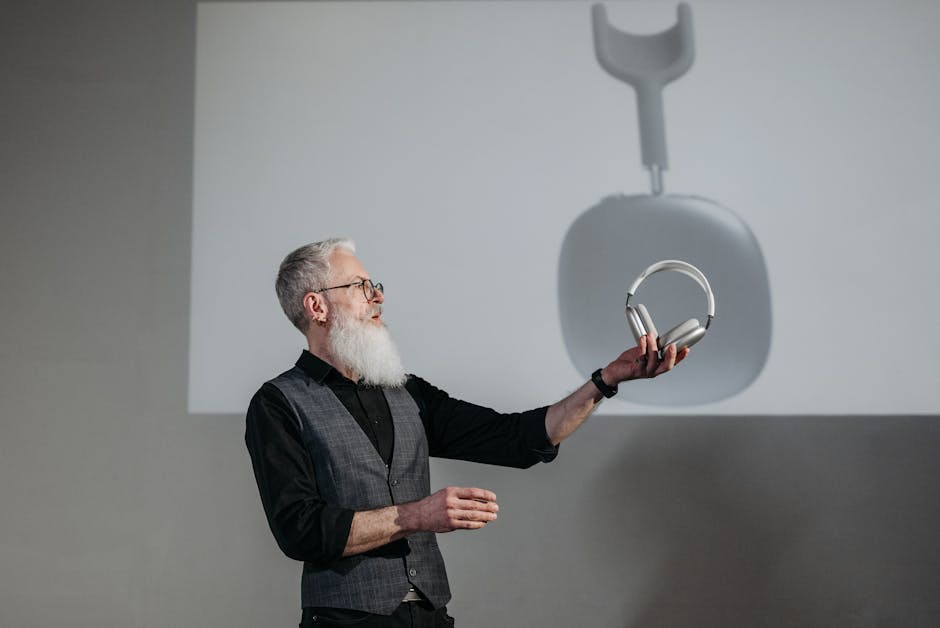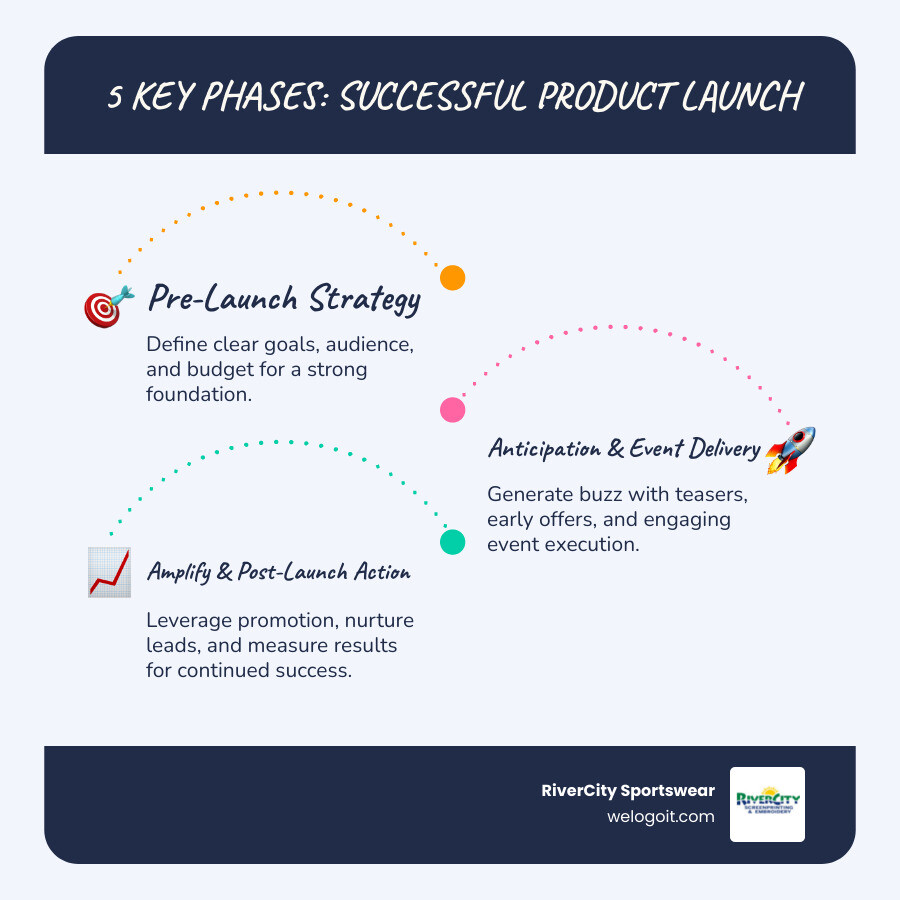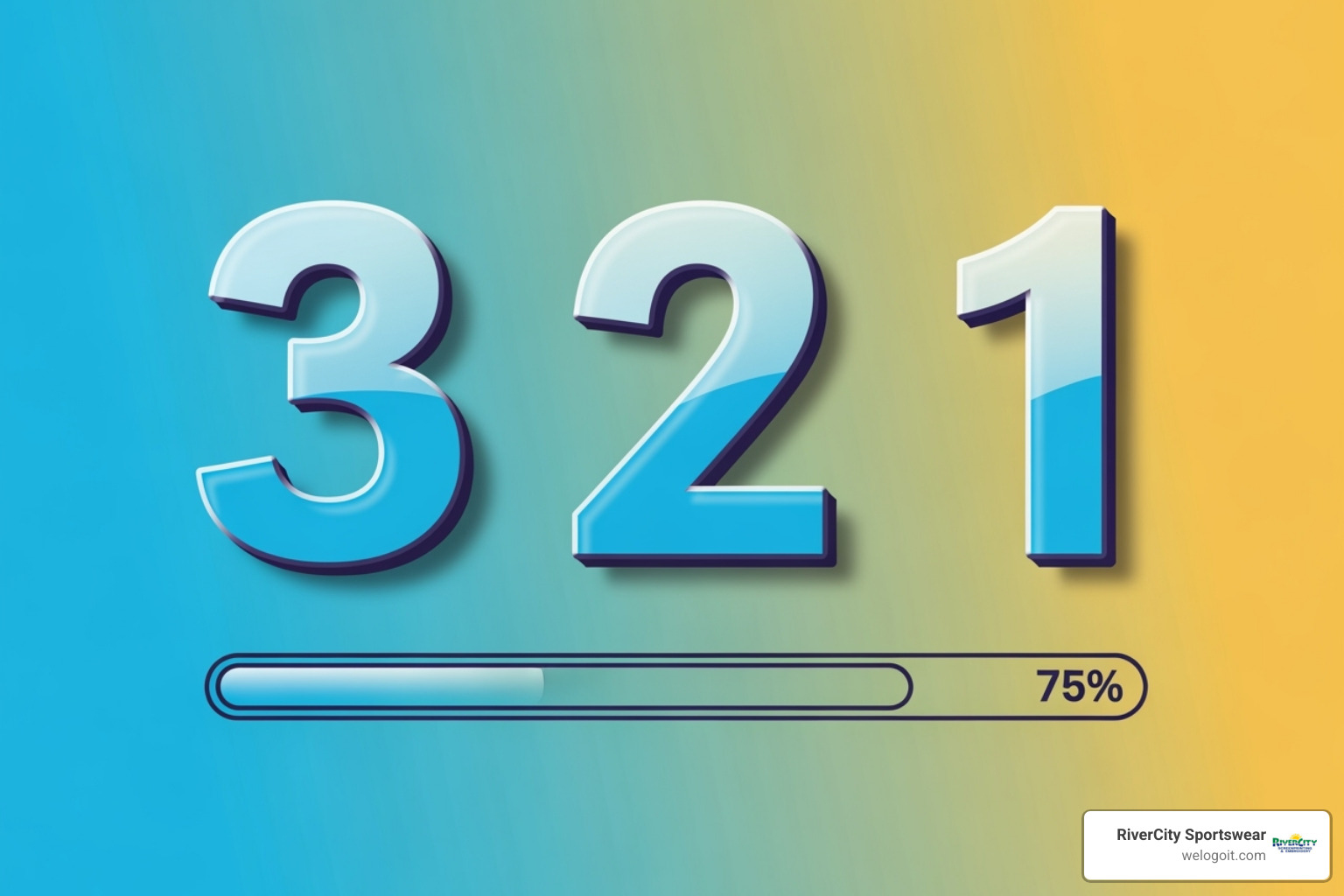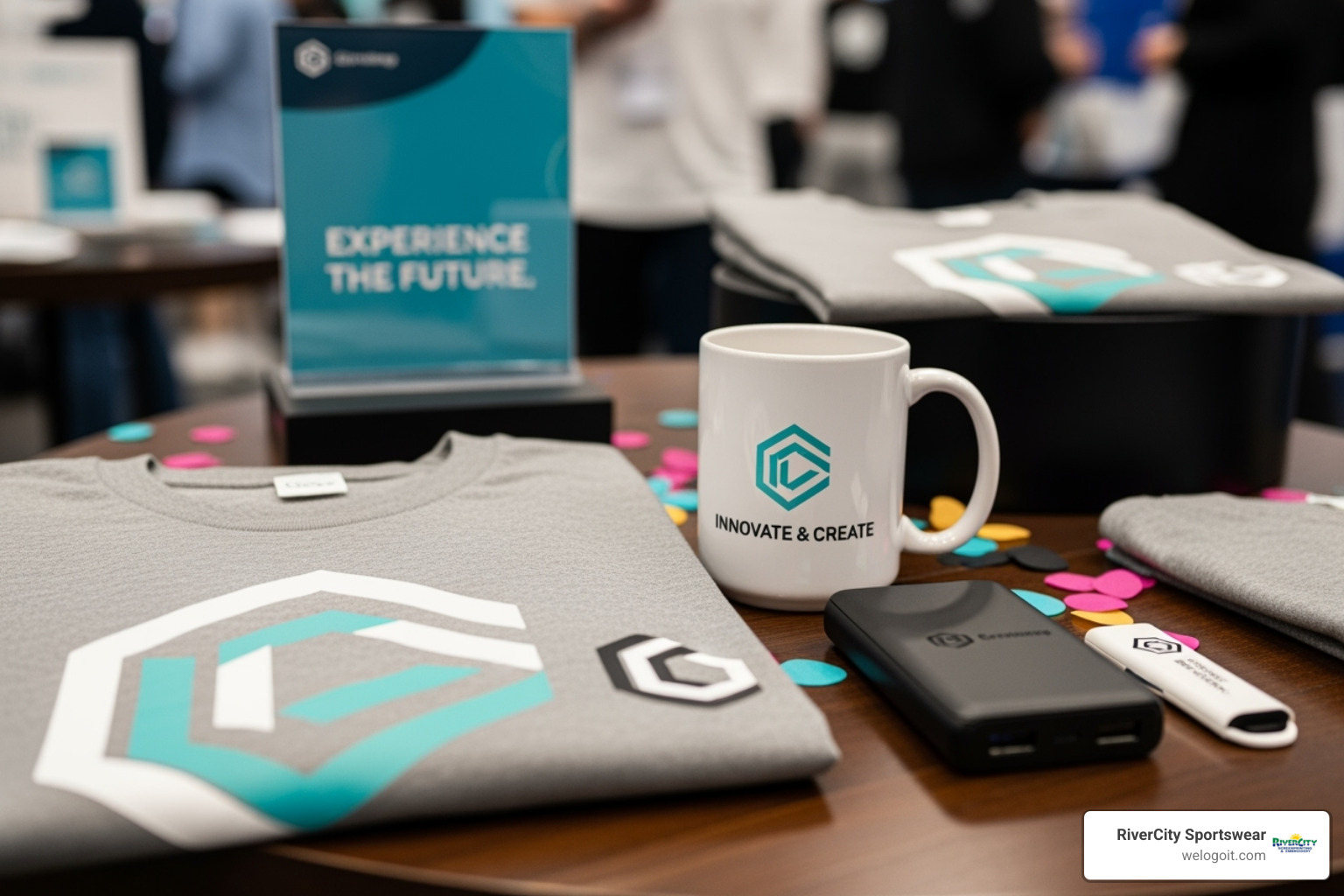
New Product, New Buzz: Crafting the Perfect Promotional Event
Why a Promotional Event for New Products Matters More Than Ever
A promotional event for new products is a strategic initiative to introduce your latest offering, generate excitement, and drive initial sales. It’s the moment when months of development meet your target audience, creating momentum that can make or break your product’s success. A successful launch involves five key phases: pre-launch planning, building anticipation, event execution, amplification, and post-launch follow-up.
The stakes are high. With 92% of product leaders now directly accountable for revenue, a well-executed launch event is more critical than ever. These events work because they create immediate brand awareness, allow direct customer engagement, drive early adoption, and provide tangible ROI.
However, according to Forrester’s Q1 2025 State of B2B Events survey, many companies undermine their impact by working in silos. The most successful launches integrate marketing, sales, and product teams from day one.
I’m Luke Sanders, and for over 15 years at RiverCity Sportswear, I’ve helped businesses execute successful launches with high-quality custom apparel and promotional merchandise. I’ve seen how the right strategy and memorable branded items can turn a product introduction into a market-defining moment.

Quick look at promotional event for new products:
Step 1: Laying the Groundwork for Your Launch
Before the lights, buzz, and crowd, a successful promotional event for new products requires a rock-solid foundation. This groundwork phase is about understanding your market, setting a budget, and defining what success looks like. According to Forrester’s Q1 2025 State of B2B Events survey, the most successful launches bring marketing, sales, and product teams together from day one. At RiverCity Sportswear, I’ve seen that skipping this step rarely ends well.
Defining the Primary Goal of Your Launch
What do you want your launch event to accomplish? Be specific. Your primary goal could be to:
- Drive immediate sales
- Generate qualified leads for your sales team
- Build brand awareness for a new market entry
- Educate customers about a complex product
- Gather valuable feedback from early adopters
As experts at LocalIQ explain, you must achieve your business goals through clear planning. Your goal will guide every decision, from the event format to the promotional merchandise you choose.
Identifying and Understanding Your Target Audience
You can’t create an effective event without knowing who you’re talking to. Go beyond basic demographics (age, location, income) and dig into psychographics (lifestyle, values, interests). What are their pain points? What problem does your new product solve for them?
Creating customer personas—fictional representations of your ideal customers—helps keep your planning focused. This understanding of market segmentation influences everything. An event for tech-savvy millennials in Austin will look very different from one for local business owners in San Marcos.
Setting Measurable Success Metrics
To prove your event worked, you need clear Key Performance Indicators (KPIs) that align with your goals. Key metrics to track include:
- Ticket sales or registrations to gauge interest.
- Social media engagement (likes, shares, hashtag usage) to measure reach.
- Website traffic to your event or product page.
- Lead generation, focusing on qualified leads.
- Conversion rates (attendees who become customers).
- Return on Investment (ROI) to measure overall financial impact.
With 92% of product leaders accountable for revenue, demonstrating tangible business impact is crucial. Setting these metrics beforehand creates accountability and provides real numbers to prove your event’s worth.
Step 2: Building Pre-Launch Buzz and Anticipation
With the groundwork laid, it’s time to generate excitement. Building anticipation is key to a successful promotional event for new products. This involves strategic communication, compelling content, and creating a sense of urgency.

Crafting a Compelling Event Page
Your event page is the front door to your launch; it must convert visitors into attendees. Ensure it has:
- A clear value proposition explaining why they should attend.
- Speaker bios and a detailed agenda to build credibility and set expectations.
- A helpful FAQ section to address common questions.
- A mobile-friendly design, as most people will view it on their phones.
- A bold, unmissable call-to-action (e.g., “Register Now”).
Creating Urgency with Early-Bird Offers
People hate missing out on a good deal. Use this to your advantage to build momentum. Effective tactics include:
- Limited-time discounts to encourage immediate sign-ups.
- Exclusive bonuses for early registrants, like premium seating or a piece of custom promotional merchandise from RiverCity Sportswear.
- Tiered pricing that increases as the event date nears.
- Countdown timers on your event page and in emails to drive action.
The benefits of early bird offers extend beyond early revenue; they help gauge interest and create a snowball effect of excitement.
Using Video Content to Generate Excitement
Video is a powerful tool for building buzz, as viewers retain almost 100% of a video message compared to just 10% when reading text. Use short, punchy videos like:
- Teaser trailers that hint at your new product without revealing everything.
- Behind-the-scenes footage to humanize your brand and show your team’s passion.
- Speaker interviews to build credibility for your event’s content.
- Product sneak peeks to generate speculation and conversation.
Share this content across all your channels—social media, email, and your event page—to amplify your message and make a lasting impression.
Step 3: 20 Creative Ideas for Your Promotional Event for New Products
The most successful promotional event for new products is creative, engaging, and memorable. Here are ideas for any budget to showcase your new product in the best possible light.

Engaging In-Person and Hybrid Event Ideas
- Pop-up Shops: Let customers interact with your product in a temporary retail space in a high-traffic area like Austin or at a San Marcos community event.
- Experiential Activations: Create an immersive environment that connects attendees with your brand on a deeper, multi-sensory level.
- Workshops and Demos: Allow attendees to learn by doing, seeing your product in action and understanding its value firsthand.
- User Conferences: Educate, inspire, and build community around your product, showcasing new innovations to existing and potential customers.
- Themed Parties: Match the party’s vibe to your product’s personality, whether it’s a spa-themed evening or an outdoor adventure.
- Product Reveal Event: Build excitement with a classic, dramatic showing, complete with live demonstrations and a Q&A session.
- Community Appreciation Days: Introduce a new product while giving back to your neighbors, building genuine brand loyalty.
- Surprise and Delight: Take inspiration from UCC’s “Gacha” coffee event, using an element of surprise to create incredible engagement.
- Creative Framing: Pure Storage hosted a humorous “retirement party” for old tech, making a technical message memorable and entertaining.
- Product-Themed Escape Room: Design puzzles that reveal product details as participants solve them for a thrilling, interactive experience.
Innovative Virtual Event Concepts
- Interactive Webinars: Go beyond presentations with live polls, Q&A, and breakout rooms to keep attendees engaged.
- Virtual Product Tours: Give customers an immersive, detailed visual exploration of your product from anywhere.
- AR/VR Experiences: Let attendees virtually “try on” products or visualize them in their own space using their smartphones.
- Live-streamed Q&A Sessions: Build trust with raw, unscripted conversations between your team and the audience.
- Virtual Sampling Events: Mail samples beforehand and host a guided live tasting or unboxing to create a shared online experience.
Low-Cost and Budget-Friendly Strategies
- Social Media Contests: Generate excitement and expand reach by asking users to share content or tag friends for a chance to win.
- User-Generated Content Campaigns: Encourage early testers to share their authentic experiences using a specific hashtag.
- Partnering with Local Organizations: Collaborate with non-competing businesses in San Marcos or Austin for cross-promotion.
- Free “Lunch and Learn” Webinars: Generate leads and establish thought leadership by providing genuine value.
The Power of Promotional Merchandise
No matter the event, promotional merchandise amplifies your impact. Research shows it can increase your chances of getting new customers by 83%. This is what we do best at RiverCity Sportswear.
A custom screen printed t-shirt becomes a walking billboard, while branded drinkware keeps your product top-of-mind daily. Swag bags filled with thoughtful custom logo giveaways create a memorable takeaway. Custom apparel also gives your team a professional, cohesive look. We’ve perfected branded merchandise for corporate events, providing exceptional service and fast turnarounds. The right promotional products extend your event’s life and reach. Ready to explore promotional products for your launch? We’re here to help.
Step 4: Amplifying Your Reach Across Channels
Even the most brilliant promotional event for new products will fall flat if nobody knows about it. To maximize attendance and engagement, you need an integrated, multi-channel marketing strategy that meets your audience wherever they are.
Leveraging Social Media and Influencer Marketing
Social media is where your audience gets excited about new things. Use it strategically:
- Create a branded hashtag to centralize conversation and track buzz.
- Use countdown posts to build momentum by spotlighting speakers and revealing perks.
- Go live on platforms like Instagram or Facebook to offer sneak peeks and host Q&A sessions.
- Partner with influencers whose audience aligns with your target market. Influencer marketing delivers an 11x higher ROI than traditional banner ads and brings credibility and reach.
- Encourage user-generated content (UGC) by running contests that ask your audience to share photos or videos with your event hashtag.
Integrating Digital and Traditional Marketing
Successful launches use both digital and traditional marketing. Combine email campaigns and SEO-optimized event pages with ad retargeting, which can have a 10x higher CTR and is 70% more likely to convert website visitors. For local events in Austin or San Marcos, bridge the physical and digital worlds by using print materials with QR codes that link directly to your registration page. Also, leverage local media outreach by sending press releases to build credibility and earn free coverage.
Case Study: Examples of Successful Launches
Learn from what others have done brilliantly.

- McDonald’s Chicken Big Mac Pop-Up: Generated massive buzz with a mysterious, unbranded pop-up that was later revealed to be theirs, combined with a major influencer livestream.
- UCC Capsule Coffee Shop “Gacha” Event: Overcame consumer hesitation by creating a fun, shareable event where customers randomly received new coffee flavors from a capsule toy machine.
- VT Cosmetics at MEGA COSME LAND: Drove engagement at every touchpoint with a multi-tiered incentive system that included online actions, in-person games, and exclusive coupons.
- Goldcast’s AI Summit: Launched a new AI tool by hosting a valuable educational summit on the topic, positioning their product as an essential solution rather than a sales pitch.
- Pure Storage’s “Retirement Party”: Used humor to make a technical product launch memorable, hosting a webinar framed as a farewell party for old technology.
These examples show the power of creativity and a multi-channel approach. At RiverCity Sportswear, we’ve seen how custom promotional merchandise, like screen printed t-shirts and branded hats, amplifies these experiences by giving attendees a tangible piece of the event to take home.
Step 5: Maximizing Post-Launch Momentum
The event is over, but the real work is just beginning. Maximizing post-launch momentum is what turns initial excitement into sustained customer relationships, actionable insights, and measurable business growth.
The Importance of Post-Launch Follow-Up
Follow-up is where you turn attendees into advocates. Keep the conversation going with these key actions:
- Send thank you emails within 24 hours to attendees, speakers, and partners.
- Use post-event surveys to gather essential feedback for refining your product and improving future events.
- Share event recordings to extend your reach and turn your event into an ongoing marketing asset.
- Nurture new leads immediately with a structured follow-up campaign while they are still “hot.”
Measuring Success and Analyzing Results
It’s time to see how you measured up against the KPIs you set in Step 1. This is about learning what worked.
- Review your KPIs: Compare your goals for ticket sales, website traffic, and lead generation against the actual results.
- Analyze attendee feedback: Look for patterns in survey responses and social media comments to identify strengths and weaknesses.
- Calculate final ROI: Compare total event costs (including venue, marketing, and promotional merchandise from RiverCity Sportswear) to the returns, such as direct sales and the value of new customers.
- Review social media analytics to understand content performance and reach.
Common Mistakes to Avoid in a Promotional Event for New Products
Avoid these common pitfalls that can derail even the most promising event:
- Poor planning: Rushing the process or launching without clear objectives.
- Ignoring the target audience: Creating an event that doesn’t resonate with your customer personas.
- Lack of promotion: Assuming people will just show up without a strong, multi-channel promotional effort.
- Technical difficulties: Failing to test and re-test all tech for virtual or hybrid events.
- No post-event follow-up: Wasting the goodwill and leads you generated.
- Inconsistent messaging: Confusing customers because marketing, sales, and product teams are not aligned, an issue highlighted by Forrester’s Q1 2025 State of B2B Events survey.
Avoiding these mistakes increases your chances of a smooth, successful promotional event for new products that delivers real business results.
Frequently Asked Questions about Promotional Events
What is the primary goal of a product launch promotion?
The primary goal of a promotional event for new products is to generate awareness, excitement, and demand. This drives initial sales, captures market share, and builds a loyal customer base. Specific goals can also include generating qualified leads, educating customers, or gathering feedback from early adopters.
How can we create a sense of urgency for a product launch?
Create urgency and encourage immediate action by using limited-time early-bird discounts, offering exclusive bonuses to the first buyers, highlighting limited stock availability, and displaying countdown timers on your website and social media channels. These tactics tap into the fear of missing out and motivate people to commit now.
What are some low-cost promotional strategies for a new product?
An effective launch doesn’t require a massive budget. Low-cost strategies include leveraging social media with organic posts and contests, encouraging user-generated content, sending email campaigns to your existing list, and partnering with complementary local organizations in areas like Austin or San Marcos for cross-promotion. You can also host free educational webinars to provide value and generate leads.
Conclusion
Creating a successful promotional event for new products is a strategic journey. It requires laying solid groundwork by defining goals and understanding your audience, building pre-launch buzz, and executing a creative and memorable event. Whether in-person in Central Texas or virtual, the experience should be amplified across multiple channels to maximize reach.
Just as important is the post-launch phase: following up with attendees, nurturing leads, and measuring results to turn a one-time event into sustained momentum. Throughout this process, high-quality promotional merchandise—like custom t-shirts and swag bags—plays a crucial role in making your brand unforgettable.
For over 15 years at RiverCity Sportswear, I’ve seen this combination of strategy, creativity, and quality promotional products turn launches into major market moments. We’re here to help you make that happen with exceptional customer service, fast turnaround, and personalized design support for everything from custom embroidered hats to comprehensive corporate event merchandise.
Your next launch deserves to be remarkable. Start planning your promotional products with us today.
Table of Contents
